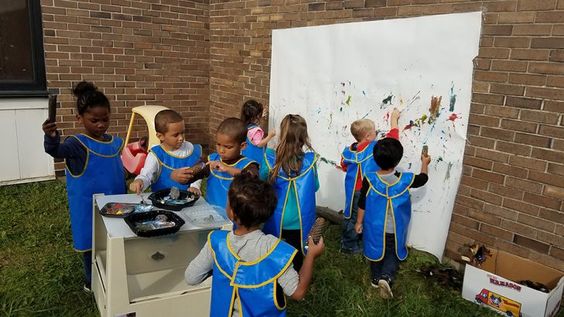- 5 Strategies to Help Your Child Move Towards a Growth Mindset
- 4 Reasons Why Growth Mindset Is Important For Kids
- 4 Best Growth Mindset Activities for Kids
- 4 Tips To Create The Best Daily Schedules for Kids
- 5 Top Tools To Design The Perfect Daily Schedule For Kids
- 8 Questions to Ask Children and Students to Develop Their Growth-Mindset
- 10 Best Growth Mindset Quotes
Did you know that how you think about intelligence can impact your child’s academic success? It’s true! A child’s mindset plays a significant role in their academic achievement and that’s why you should nurture to build a growth mindset for kids.
Math & ELA | PreK To Grade 5
Kids see fun.
You see real learning outcomes.
Watch your kids fall in love with math & reading through our scientifically designed curriculum.
Parents, try for free Teachers, use for free
If your child has a growth mindset, they believe that intelligence can be developed. They understand that effort leads to success, and they are not afraid to take on challenging tasks. This type of thinking leads to increased motivation and higher levels of achievement.
On the other hand, if your child has a fixed mindset, they believe that intelligence is set in stone. They are more likely to give up when faced with a challenge, and they are less likely to take risks.
So, what can you do to help your child nurturing a growth mindset? Read on for our complete guide.
What is a Growth Mindset for Kids?

As per wikipedia, growth mindset definition for kids simply put is that “they believe everyone can get smarter if they work at it”. In other words, a growth mindset is a belief that intelligence and abilities can be developed with effort and practice. Kids with a growth mindset see mistakes and setbacks as an opportunity to learn and grow rather than a sign that they’re not smart or talented.
There are many benefits to having a growth mindset. Kids with a growth mindset are more resilient and adaptable, and they’re more likely to take on challenging tasks. They’re also more likely to enjoy learning and persevere when things get tough.
Related Reading: Best Growth Mindset Books for Kids
Growth Mindset Vs Fixed Mindset
If your child has a growth mindset, they believe that intelligence can be developed. They understand that effort leads to success, and they are not afraid to take on challenging tasks. This type of thinking leads to increased motivation and higher levels of achievement.
On the other hand, if your child has a fixed mindset, they believe that intelligence is set in stone. They are more likely to give up when faced with a challenge, and they are less likely to take risks. So, what can you do to help your child in nurturing a growth mindset? Read on for our complete guide.
5 Strategies to Help Your Child Move Towards a Growth Mindset

Now that you understand a growth mindset and its benefits, it is essential to learn how to help your child develop one. Though some children may be more inclined towards a growth mindset naturally, every child can benefit from learning growth mindset strategies. Therefore, let’s see various strategies to encourage a growth mindset in your child.
1. Praise the Effort, Not Innate Ability
When your child succeeds at something, resist the urge to say things like “You’re so smart!” or “You’re a natural at this!” Instead, focus on praising the hard work and effort that your child put in. For example, you could say, “You must have worked really hard at this!” or “I can tell you put a lot of thought into this!” This type of praise will help your child understand that success comes from effort, not an innate ability.
2. Help Your Child See Failure as an Opportunity to Learn
If your child experiences failure, it is important to help them see it as an opportunity to learn and grow. Avoid reacting negatively, and instead, encourage your child to view failure as a step towards success. This can be a challenging mindset shift for both you and your child, but it is crucial for growth mindset development.
3. Encourage a Love of Learning, Not Just Good grades
One of the best ways to encourage a growth mindset is to foster a love of learning in your child. Help them see that learning is an ongoing process, not just something they do to get good grades. Encourage curiosity and exploration. When your child is interested in a topic, help them explore it further. This will help them develop a growth mindset and a love of learning that will last a lifetime.
4. Help Your Child Find Their Passion
Another way to encourage a growth mindset is to help your child find their passion. When children are passionate about something, they are more likely to stick with it even when things get tough. This tenacity is a key component of a growth mindset. If your child doesn’t yet have a passion, try exposing them to a variety of activities and see what sparks their interest.
5. Start with Yourself
If you want to help your child develop a growth mindset, it is essential to start with yourself. Model growth mindset behaviors and attitudes yourself. When you make mistakes, admit them and talk about what you learned from the experience. When you face challenges, persevere and don’t give up. Be patient with yourself and your child as you both work on developing growth mindsets.
Related Reading: Best Educational Websites for Kids that Spark Curiosity
4 Reasons Why Growth Mindset Is Important For Kids

With a growth mindset, kids understand that intelligence is not fixed. They know that they can get more competent and improve their skills with effort and practice. Here are just a few reasons why kids need to have a growth mindset:
1. Increased Motivation
A growth mindset for kids leads to increased motivation. This is because kids understand that they can improve their abilities and skills with effort. They don’t give up easily and see obstacles as challenges to overcome.
2. Improved Resilience
Kids with a growth mindset are more resilient in the face of setbacks. They don’t see failures as a reflection of their worth as a person but rather as an opportunity to learn and grow. This helps them persevere in the face of challenges and view setbacks as a normal part of life.
3. Greater Enjoyment of Learning
When children have a growth mindset, they see learning as an opportunity to grow and improve rather than something that is only about getting good grades. This means that they are more likely to enjoy learning for its own sake, which leads to greater motivation and engagement in the classroom.
4. Higher Levels of Achievement
Because of a growth mindset, kids are more resilient and motivated, and they tend to achieve at higher levels. Studies have shown that growth mindset interventions lead to improved grades and test scores and increased motivation and engagement in learning.
Related Reading: Best Reading Websites For Kids
Let’s Dive Into the Mindfulness for Growth Mindset

Mindfulness is a valuable tool that can help you foster a growth mindset. When you are mindful, you observe your thoughts and feelings without judgment. This allows you to see your mistakes as learning opportunities and to approach challenges with curiosity and openness. Practicing mindfulness can help you develop a growth mindset and teach your child to be more mindful.
We have discussed that one way of nurturing a growth mindset in your child is by guiding their way of thinking. Another method is by incorporating activities in their daily routine; designed to shift their perspectives, cultivate resilience, and ignite in them the passion for learning and development. So, let’s take a look at them!
4 Best Growth Mindset Activities for Kids
A growth mindset isn’t just a belief; it’s a journey of transformation. If you believe growth is progressive and achievable, you have to work every day in this direction so that the change eventually becomes visible. Following are a few activities to create a growth mindset for kids:
1. Obstacle Course
Create a physical obstacle course. As participants navigate challenges, discuss how they approached each obstacle and what strategies they used.
2. Famous Failures
Explore stories of successful people who faced failures before achieving greatness. Discuss what they learned from their failures. When they realize that success is preceded by failed attempts to succeed, they will not be bogged down by failures but will only try to work upon the shortcomings that hindered them from achieving.
3. Journaling
Encourage regular reflection through journaling. Participants can write about challenges, setbacks, and how they plan to approach them with a growth mindset. This journaling will make them more solution-oriented and, at the same time, teach them how to chalk out a step-by-step plan for success.
4. Positive Self-Talk
Teach children to replace negative self-talk with affirmations and encouragement. It’s better to say, “I am still learning how to drive; I am trying to make fewer mistakes every next time.” instead of saying, “I am so inept at driving! I can never do this right!” In the negative example, the individual is harshly criticizing themselves and making a sweeping negative judgment based on one mistake. This kind of self-talk can lead to feelings of helplessness and low self-esteem. In the positive example, the individual acknowledges the setback but frames it as an opportunity for growth. This promotes resilience and self-confidence.
After discussing the activities to train a child’s mind to think progressively, let’s see what the daily schedule of a child should look like in order to discipline his mind to work in the direction of growth constantly.
Related Reading: Fun Problem-Solving Activities for Growth Mindset
Making A Daily Schedule To Nurture A Growth Mindset for Kids
When making a daily schedule for kids, making the process collaborative and integrated is essential. The schedule should not feel forced upon the child but be a mutually acceptable decision to strengthen your child’s daily productivity.
Using online tools and daily schedule planners is the right way to create a robust day-wise plan. Some of the best online schedule designers can also be integrated with emails, calendars, and other apps to integrate the plan within your smartphone seamlessly.
4 Tips To Create The Best Daily Schedules for Kids

- Prioritize a Growth Mindset
One of the best ways to make schedules meaningful is to allow for mindfulness, positive thinking, and activities that encourage growth mindset development. This includes meditation, yoga, reading, and other activities to strengthen introspection and early self-development.
- Backup Activities
Cancellations and delays are a normal part of every schedule, so it is essential to have backup activities. This also ensures minimal downtime due to changes, and kids are engaged throughout the day.
- Include Active Choices in Schedules
The best way to make daily schedules more impactful is to have them be motivational rather than a strict routine. You can add options within set schedule times to have kids choose which activities they want to go for. They can select an hour of reading or an hour of online learning for each day.
- Collaborate On a Schedule That Works
Collaboration is important when designing the right schedule, so adding activities that your child loves is essential. Setting an end time is equally as important as setting a starting time, as kids know precisely when to come home after playing outside.
We have discussed what your child’s daily schedule should include. Let’s explore the designing tools to show you what your child’s daily schedule would look like.
5 Top Tools To Design The Perfect Daily Schedule For Kids

There are many tools for creating a daily schedule for kids, so it is important to select the one that is flexible, creative, and scalable for planning out a whole month or a few weeks. A daily schedule for kids should also be easily editable so that you can introduce new changes faster.
1. Canva – Daily Planner
Canva offers a daily planner template that allows you to quickly create daily schedules for kids without any hassles or limitations. You can choose from dozens of themes, colors, and ideas while making the schedule creatively expressive to excite children about their day. The movable blocks can also be customized for specific types of planners, with multiple choices and colorful designs.
2. Visme – Free Schedule Maker
Using the application, you can create a highly organized and graphically interesting schedule for your kids. Through its templates and pre-made designs, you can quickly get started within minutes and create a perfect printable schedule. You can even create schedules for special classes, hobbies, and other aspects for better customizability.
3. Adobe – Online Schedule Maker
Adobe offers you a range of templates and an online schedule-making tool to get started. You can choose your design, browse thousands of templates, and add images and typography to create your schedule. You can share it online or download a digital copy, or even have it printed professionally to hang in your child’s room.
4. Vista – Printable Online Schedules
Vista provides an online schedule-making tool that can help you design creative schedules instantly. You can access more than fifty thousand templates and millions of images with the professional version. You can save different templates to make different types of schedules for each month to make it an interactive and creative form of planning.
5. Printable Tiles And Activities
Etsy offers printable daily schedules for kids that can be purchased and printed at home. They are ideal for younger children who respond best to visually appealing messages. The daily schedule also has a chore chart, activities for the day, the time, and other essential elements needed to have a handy schedule. You can pick them up and print them out instantly.
Scheduling your child’s day is the best way to improve their productivity. SplashLearn offers highly productive games and learning experiences to maximize screen time output.
You can access hundreds of games, activities, and quizzes for kids to improve their productivity and output in class. From Pre-K to grade 5, there are specially designed math and ELA games and worksheets to engage students holistically.
It’s important to give your child a set routine, but we should not expect them to follow it even if they do not believe in it. Their understanding and participation in creating it is equally important. So, let’s discuss the kind of questions you should ask your child to brainstorm with them and make them deduce the logic behind setting their routine as per yours and their collaborative decision.
8 Questions to Ask Children and Students to Develop Their Growth-Mindset
“Good teaching is more a giving of right questions than a giving of right answers.” Josef Albers.
Indeed, asking the right questions does develop a child’s logical and critical thinking skills that widen their horizon of thinking. Following are a few examples of the questions that encourage self-reflection, resilience, and a growth-oriented mindset. They make students focus on their efforts, strategies, and the potential for improvement rather than fixed traits or outcomes.
- What did you learn from your mistakes?
- What strategies did you use to solve that problem?
- How could you approach this differently next time?
- What challenges are you excited to take on?
- What steps have you taken to improve in this area?
- What’s a challenge that you’re facing right now? How can you work through it?
- What’s one thing you’re proud of that requires effort and determination?
- How do you feel when you see someone else succeed?
The child’s effort to answer these questions improves their reflection and steers them in the direction of developing a never-give-up attitude. Another way of nurturing a positive growth mindset in kids is by telling them famous inspirational quotes to keep them motivated to seek improvement.
10 Best Growth Mindset Quotes
Just like a plant needs to be nurtured every day, so do your thoughts. Inspirational quotes do just that. They supply your thoughts with the right amount of nourishment to keep you going in the moments you feel exhausted. Following is a list of some of the best quotes that never let you say goodbye to your dreams.
- “Live as if you were to die tomorrow; learn as if you were to live forever.” – Mahatma Gandhi
- “Most of the important things in the world have been accomplished by people who have kept on trying when there seemed no hope at all.” – Dale Carnegie
- “Nothing is IMPOSSIBLE. The Word itself says I’M POSSIBLE!” – Audrey Hepburn
- “It is hard to fail, but it is worse never to have tried to succeed.” – Theodore Roosevelt
- “Success is not an accident, success is a choice.” – Stephen Curry
- “No problem can withstand the assault of sustained thinking.” – Voltaire
- “It’s not that I’m so smart. It’s just that I stay with problems longer.” – Albert Einstein
- “Twenty years from now, you will be more disappointed by the things that you didn’t do than by the ones you did do. So sail away from the safe harbor. Explore, Dream, Discover.” – Mark Twain
- “Success is the ability to go from one failure to another with no loss of enthusiasm.” – Winston Churchill
- “Always do what you are afraid of doing.” – Ralph Waldo Emerson
Related Reading: Best Good Vibes Quotes to Help You Better Your Day
Conclusion
So, what does all of this mean for you and your child? A growth mindset is key to helping children achieve success in school and life. It allows them to embrace challenges and learn from their mistakes. When parents help their children develop a growth mindset, they set them up for a lifetime of success.
We hope this guide has given you some practical ways to encourage growth mindset development in your child. With a little bit of effort, you can help your child develop a growth mindset that will serve them well throughout their life. So make sure to keep these tips in mind and put them into practice.
Related Reading: Best Motivational Songs for Students to Inspire a Growth Mindset
Frequently Asked Questions (FAQs)
How can I tell if my child has a growth mindset?
A few signs may indicate your child has a growth mindset. These include being willing to try new things, being open to feedback, and seeing mistakes as opportunities to learn.
What is the difference between a growth mindset and a positive mindset?
A growth mindset focuses on learning and improvement, while a positive mindset focuses on thinking positively about oneself. Both are important for early childhood development.
How do I make a daily schedule for kids?
For an utterly customizable option, you can opt for online schedule makers. If you want a premade template, you can find online printable versions, such as Etsy.
























